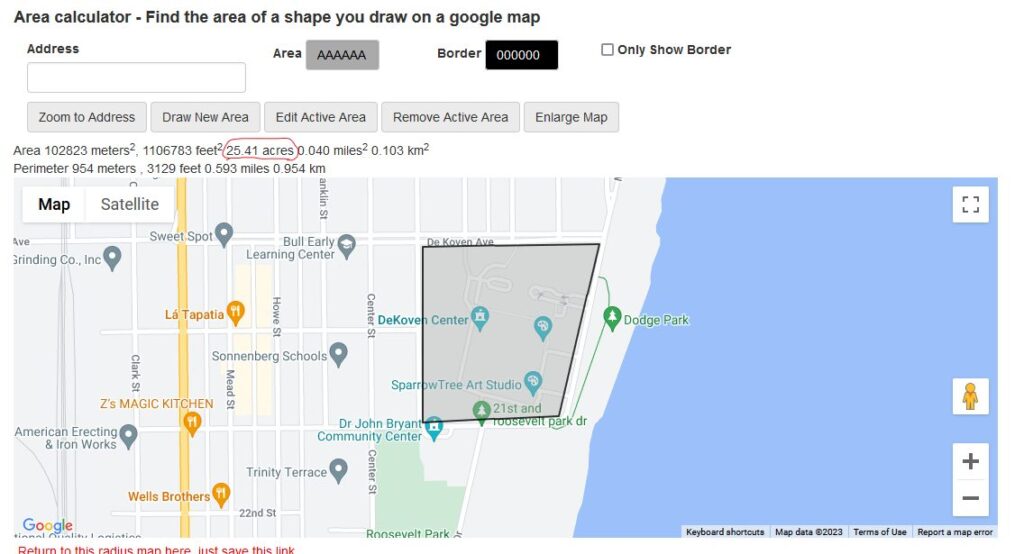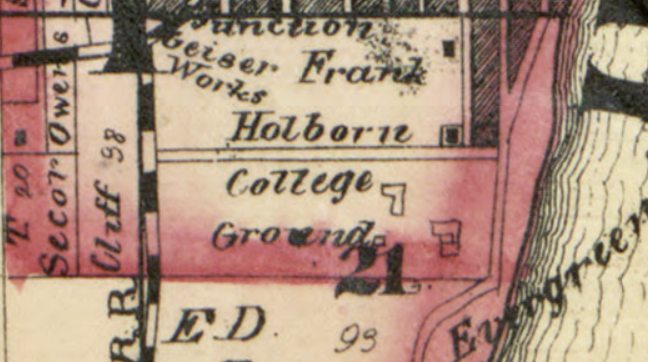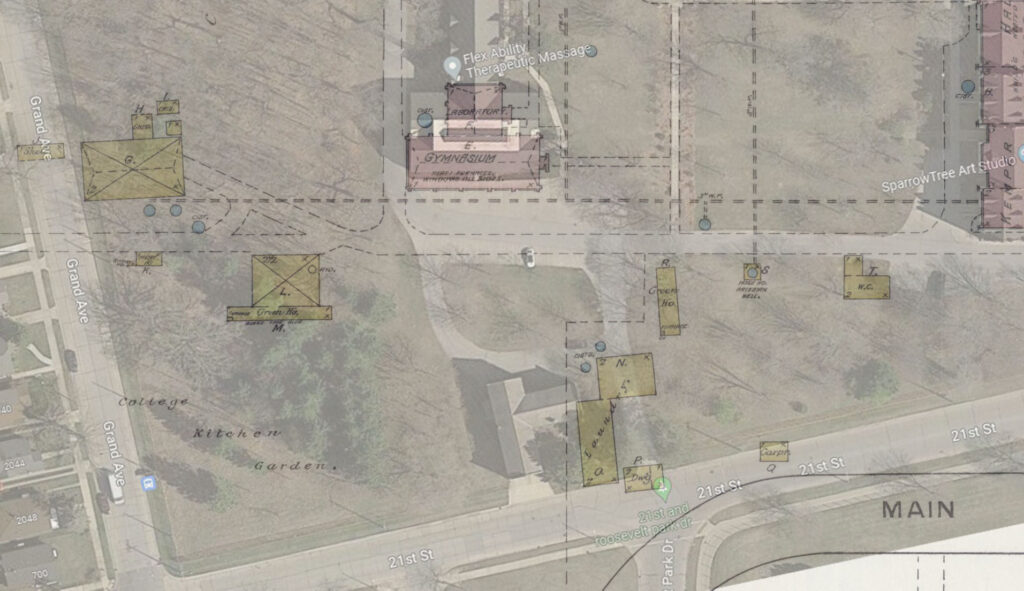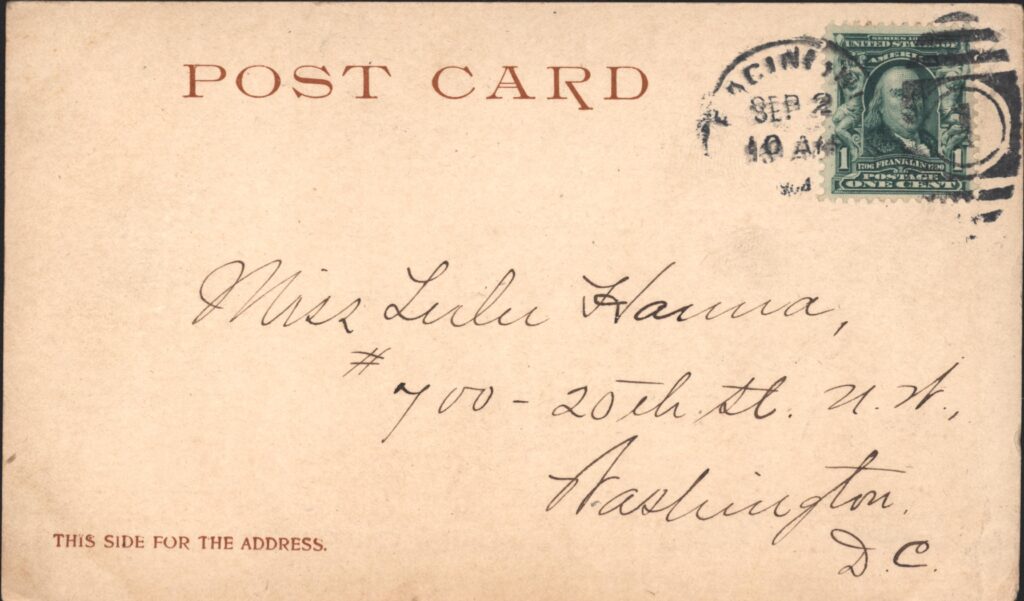Different phases in the life of this institution:
Early years (1852-1859)
DeKoven era (1859-1879)
Decline as a college (1879-1889) (after death of DeKoven)
Preparatory school and later years (1889-1933)
Closure and recent history (1933-present)
http://www.vindustries.com/racine/0_dekoven.shtml
1875-6 Racine Miscellaneous Directory, published by Murphy & Co.,
City, State and Railroad Directory and Gazetteer Publishers, 105
Wisconsin St., Milwaukee, Wi.
NEWSPAPERS
College Mercury, (Literary) Students of Racine College, pub. and
Proprs. Racine College; H.H. Martin and A.B. Eldredge, editors;
Semi-monthly, $2 per year, issued 1st and 2nd Saturdays of each
Month; established 1867.
The Death and Funeral of James DeKoven
“THE DEATH OF OUR WARDEN.” This phrase of five words was the headline of the article which appeared in The College Mercury of Racine College on April 7, 1879. Its simplicity in many ways underlines the impact that the unexpected death of James DeKoven had on the school, its students and staff, the city of Racine, and the Episcopal Church of the United States. The opening paragraph of this article is a summation of this event and its effect:
On the morning of the 19th of March, the Rev. James DeKoven, D.D., Warden of Racine College, died of apoplexy. As the news of his sudden death spread through the College and Grammar School, the scene was affecting in the extreme. Each felt as though a revered parent was gone. Tears came to the eyes of many a youth, who had long since come to manly strength and stature.
The April 7th issue of the Mercury was the first to be published after March 19. The editors provided an overview of the life of DeKoven, the events following his death and the many tributes paid to him throughout the country.
DeKoven’s health. In January of 1879, DeKoven fell on an icy sidewalk in Milwaukee and broke his ankle. The accident happened early in the morning as he walked to the station to get the first train for his return to Racine. He could not get up and went unnoticed for almost an hour. His Racine doctor, John G. Meachem, described his progress of recuperation as good and expressed no concerns about his general health. Meachem does mention DeKoven’s worries about his weak heart: “His mother died of paralysis, lingering paralysis, and he had great dread of being himself the subject of the same disease.”
The Funeral. James DeKoven died on Wednesday the 19th and his funeral was held on Saturday the 22nd of March during a blizzard in Racine. The description of his funeral in the Mercury is very complete. Following the directions given by DeKoven before his death, there were three celebrations of Holy Communion on the morning of his burial at 7, 8, and 9 o’clock. A public viewing of his body occurred after the nine o’clock service. The actual funeral service took place at 11 a.m. and began with a formal procession from Taylor Hall to St. John’s Chapel. This involved not only the Racine College Community but former students, visiting clergy, citizens and elected officials of Racine and Wisconsin. At the conclusion of the service the procession moved from the chapel to the grave accompanied by the hymn “For all the saints who from their labors rest.” The spot chosen for his tomb is on the south side of the chapel under the window nearest to his seat inside.
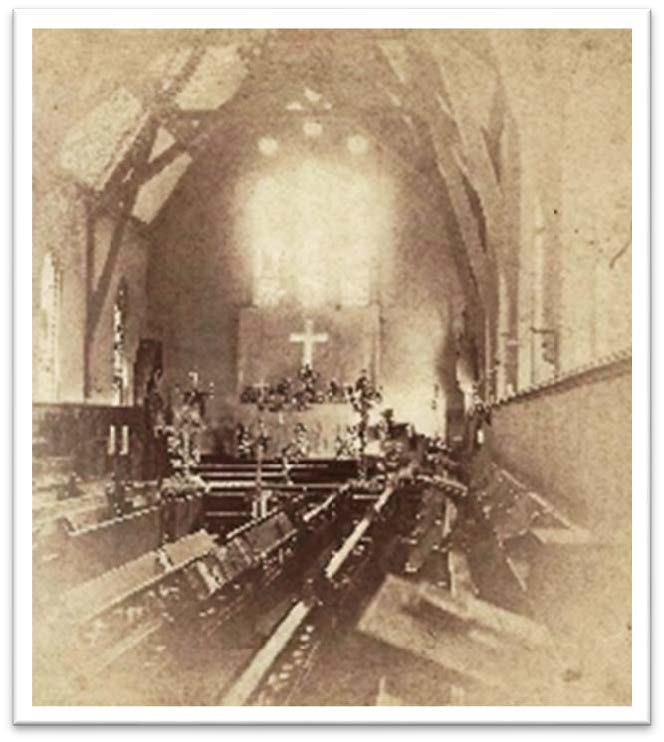
The description of the chapel and the burial service is quite detailed. Special attention is given to the many floral tributes that were sent to the college for the funeral. Among the different detailed descriptions is the following.
The tribute of the old students now resident in Chicago was a cross five feet high of choice white flowers. On the upper arm of the cross was a large
crown of tea roses with a band of purple flowers. At the intersection of the cross were the letters I.H.S. in scarlet blossoms. The based consisted of three broad steps inscribe with purple violets with the prayer, ‘Grant, O Lord, eternal rest.’
The photo that accompanies this article was taken the morning of the funeral and shows the profusion of flowers in St. John’s Chapel. Memorial services in DeKoven’s honor were held in many churches around the country.
The widespread nature of the articles which began appearing on March 20, 1879, attest to DeKoven’s celebrity. The contested episcopal election in Illinois in 1875 had obviously contributed to his fame. From his little college in Wisconsin he had come to be known throughout the United States.
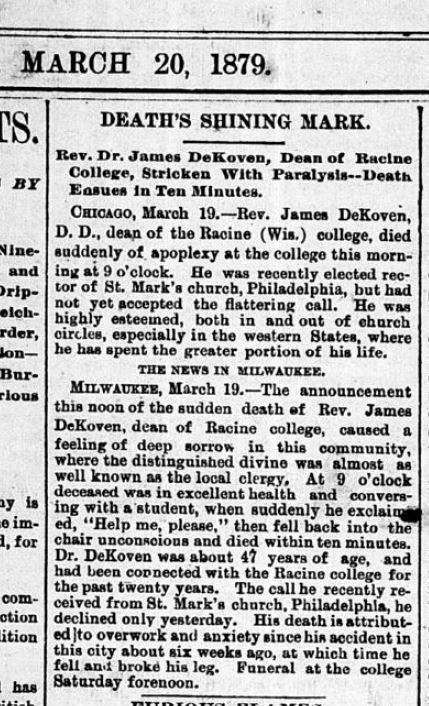
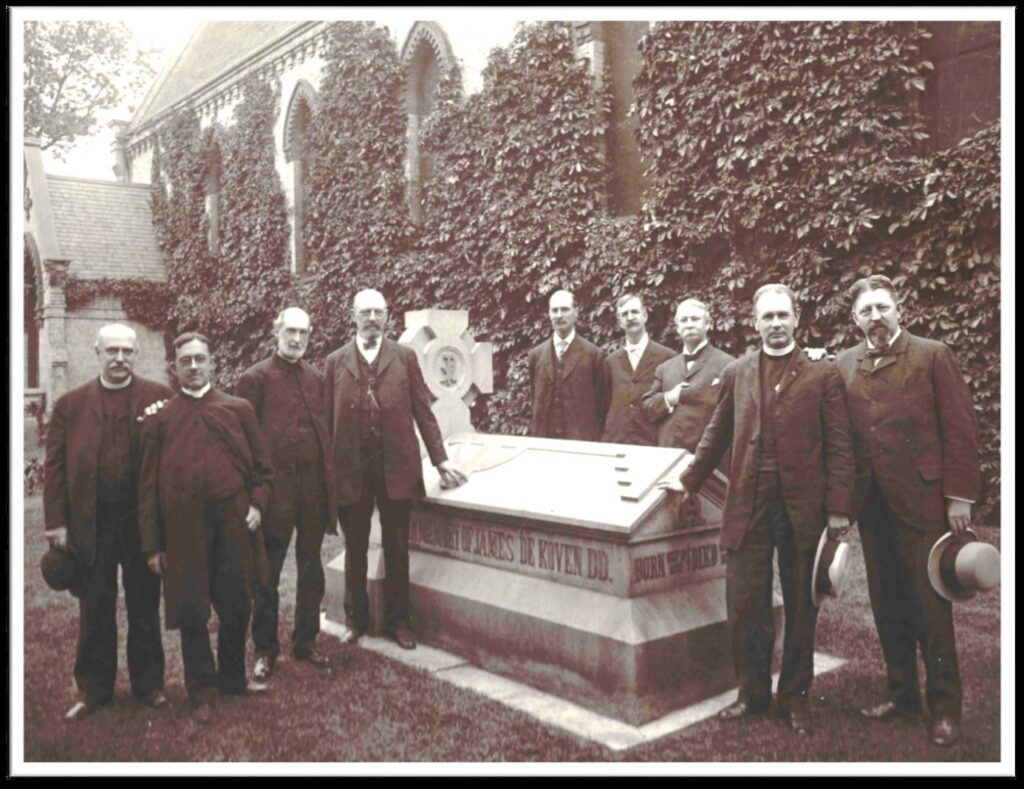
Pictured from left to right:
The Rev. Dr. Arthur Piper (1845-1930)
A graduate of Racine College and Nashotah House, Piper served for more than a quarter century as rector of St. Luke’s, Racine. For three years he served as Warden of Racine College and as College President for ten years. He also served as president of St. Luke’s Hospital and chaplain at Taylor Orphanage.
The Rev. Luther Pardee (1848-1930)
Pardee served in various parishes in the Chicago area and as Dean of St. James Cathedral. The Rev. John Coleman (1846-1920)
A graduate of General Theological Seminary, Coleman served parishes in Philadelphia, Michigan and Connecticut retiring in 1879. Eventually, he moved to England where he died in 1920.
Mr. John O. Slemmons (1847-1924)
Slemmons was one of the oldest and most widely known traveling salesmen in the jewelry business, representing J.B. Bowden & Co. when he retired in 1919.
Mr. Frank O. Osborne (1849-1931) After a successful business career in Chicago, Osborne became a prominent attorney in St. Paul, Minnesota. A graduate of Racine College and Harvard Law School, he was a trustee of Racine College for several years and was the last surviving member of his class when he died in 1931.
Mr. Alfred Sorenson (1850-1939)
Alfred Sorenson was a well-respected Omaha newspaperman and author of The Early History of Omaha.
4 The College Mercury, Racine College, April 7, 1879, Vol. XXV, No. 2, p. 1.
Chief Justice John B. Winslow (1851-1920)
After receiving a B.A. in 1871 Winslow later joined Racine College faculty as an instructor of Greek. Graduating from the University of Wisconsin Law School in 1875, he served as Racine city attorney for three years until being elected a circuit court judge for Racine, Kenosha and Walworth Counties. Elected to the Wisconsin Supreme Court in 1891, Winslow served for 29 years, the last 13 years as the chief justice.
The Rev. Dr. MacLean (1848-1930)
The Rev. Dr. T. W. MacLean served parishes in Minnesota and Joliet, Illinois.
Ex.-Gov. William Rush Merriam (1849-1931) Merriam served in the Minnesota House of Representatives in 1883 and 1887 and was the Speaker of the House in 1887. He was elected as the 11th Governor of Minnesota and served from January 9, 1889 to January 4, 1893
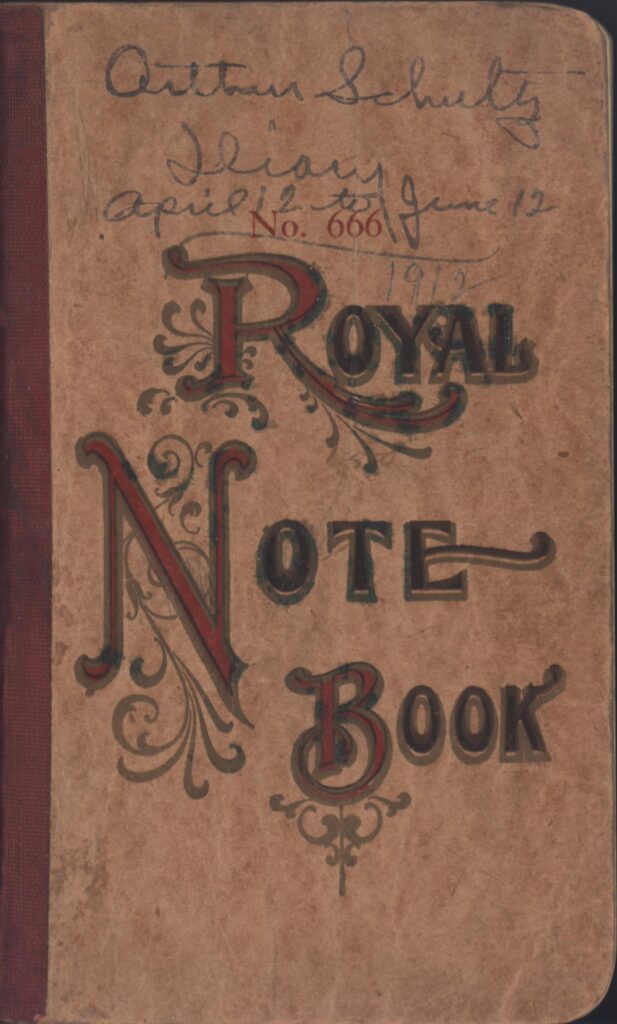
I finally found one of the Racine College ghost stories I had been looking for. This one stuck in my mind:
I am a Racine resident and am 100% convinced based on my own personal experiences that the Dekoven Center is haunted. I worked for a local caterer and we would cater weddings there using the basement of the old chapel for our work area. When being down there we have had the sinks on full blast filling up water pitchers and all of a sudden they will shut off. When standing at those sinks with your back to a sub basement area where an old unused bathroom is you feel like someone is watching you like they are down in that sub-basement area. There’s a staircase that goes up from the basement to an old office area and you hear what sounds like a chair moving in that office. We saw a figure of a man when looking up the stairs towards the office once. Your arm hair stand on end if you are ever down there alone. If you leave something on a table down there and come back it will be on the floor. It’s just a super creepy place and I have worked there at least 10 times and every time something creepy happens.
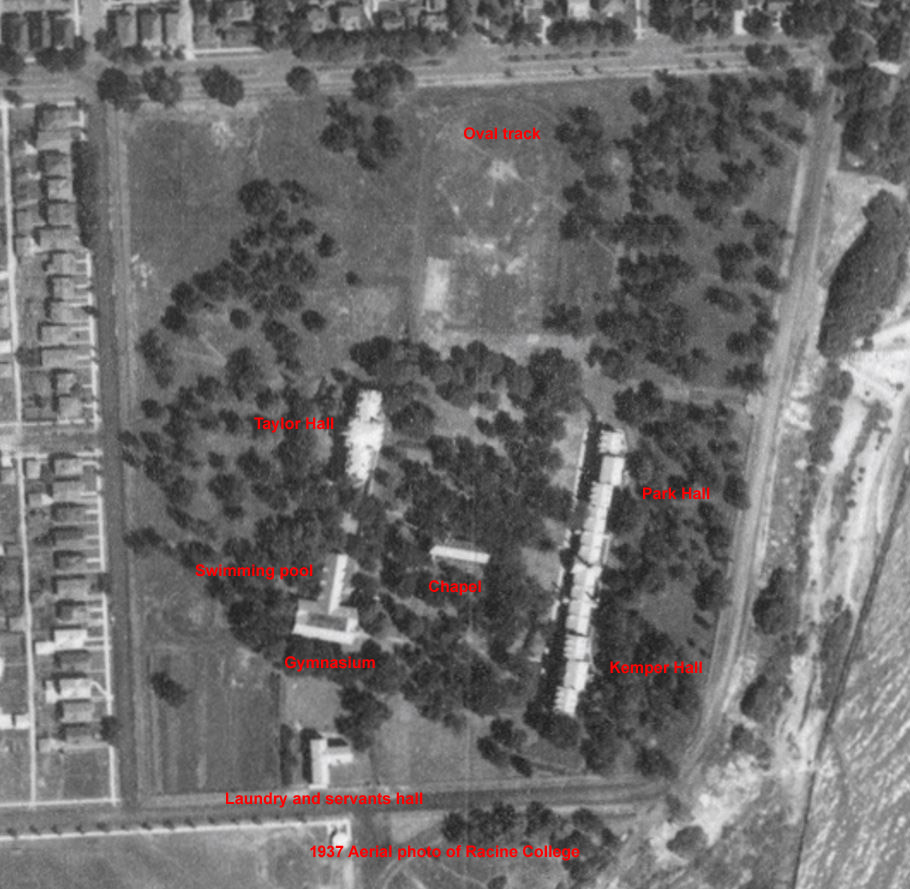
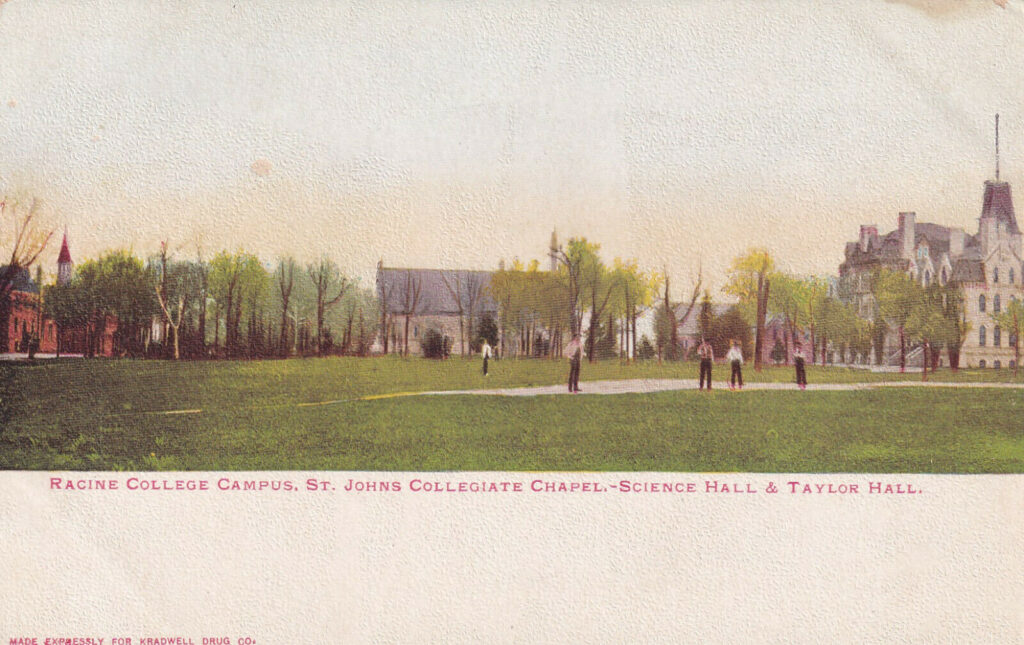
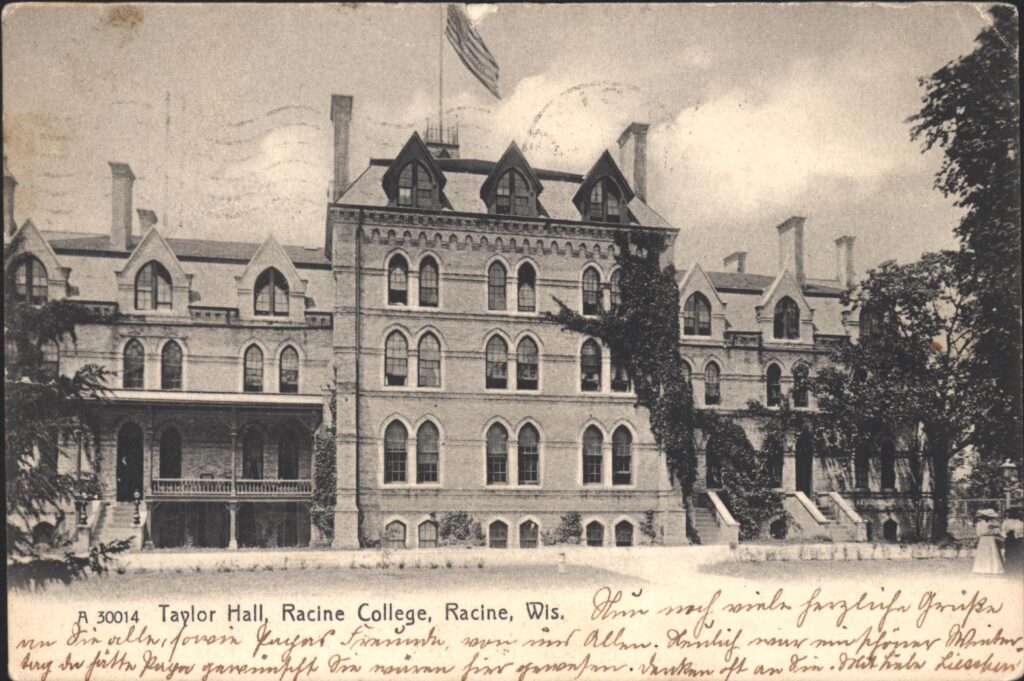
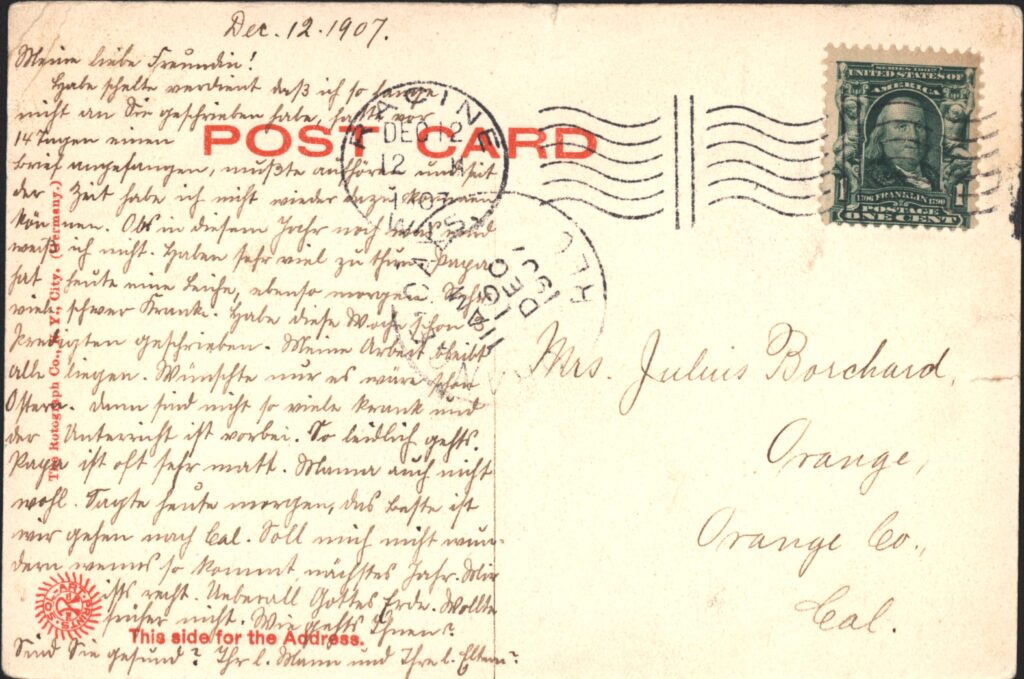
Update: This postcard was written in German handwriting called kurrentschrift, and most people can no longer read it. I found someone on fiverr who transcribed this letter and then I was able to run it through Google Translate. Here is the translation:
Dec 12. 1907. My dear friend! I deserve a scold that I’ve been so long didn’t write to you 14 days one Letter started, had to stop and since the time i didn’t get back to it can. Will there be anything else this year? I don’t know. Very busy, papa has a corpse today, same thing tomorrow. Very many seriously ill. Already have this week written sermons. My work stays all lie. Just wish it was Easter. Then not so many are sick and class is over. It’s so bad. Dad is often very tired. Neither does mom probably. Said this morning the best is we go to Cal. Shouldn’t I wish-because if it comes like that, next year. To me that’s right. Everywhere God’s earth. Wanted not earlier. How are you all! Are you healthy? your l. husband and your l. Parents? Many warm greetings to all of you, as well as papa’s friends, from all of us. The other day was a beautiful winter dad would have wished you had been here. Think of you often. With love Lieschen.
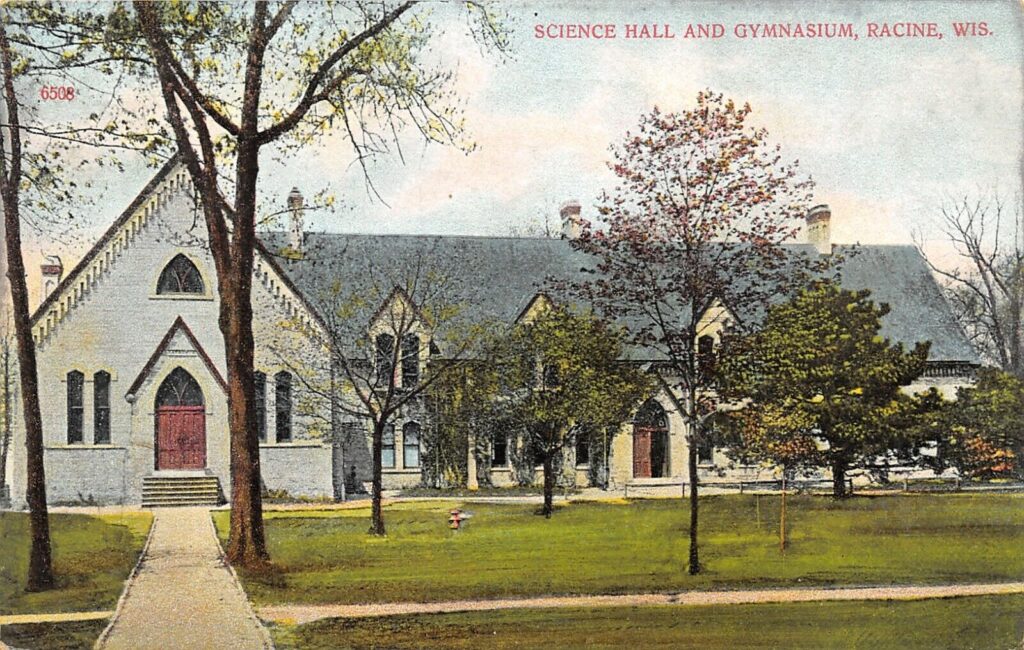
This is one of my favorite buildings to look at when I visit Racine College (Dekoven). Earlier in its life, this building was half its current size.
Racine Journal, July 30, 1879 (recall that Dr. DeKoven died on March 20, 1879)
Racine College
A visit to that Institution and the Details Elicited.
Everything relating to Racine College has more than ordinary interest for Racine people, also to a large and growing list of friends outside of our limits. We append below many item of information put in shape after a very pleasant interview of an hour or two with Mr. W. H. Amos, Curator. At this season of the year the grounds and surroundings of the college look really beautiful. The fresh green lawn under the trees is highly suggestive of coolness and comfort during the summer heat. Beautiful beds of flowers and clinging ivy that festoon some of the buildings give an added charm. The entire features are not unlike many such scenes in England, visitors who have seen both, often remarking this likeness. The buildings themselves have a substantial and imposing appearance, convenient and well adapted to the college use. As the years go on and all needed improvements are added the college will rank at the very head of educational institutions in the Union.
Desiring in an article of this kind to give some real information as to the college and its affairs, we begin with a list of Professors as follows:
Rev. Stephens Parker, D. D., Warden.
Rev. Alex Falk, Ph. D. D. D., Professor of Modern Languages.
Rev. J. J. Elmendorf, S. T. D., Professor of English Literature.
Rev. Jno. H. Converse, A. M., Professor of Greek and Latin.
Rev. F. S. Luther, A. M., Professor of Chemistry.
Gerald R. McDowell, A. M., Head Master of Grammar School.
Rev. Watson B. Hall, A. M., Master in the Grammar School.
Rev. Arthur Piper, A. M., Head of Park Hall.
Rev. W. J. Gold, B. D., Master in the Grammar School.
F. S. Martin, A. B., Head of Taylor Hall.
H. V. Rutherford, A. B., Master in the Grammar School.
Floyd B. Wilson, A. M., L. L. B., Lecturer in Elocution.
In addition there are three positions as Masters in the Grammar school at present vacant.
We pass next to a brief statement of the missionary and religious work performed by the professors and students outside their regular college duties.
Rev. M. Converse has charge of the religious exercises at the Taylor Orphan Asylum.
Dr. Falk preaches every Sunday at the little mission chapel near the Junction.
Rev. Mr. Hall goes to Burlington and preaches every Sunday. A citizen of that place has offered ground on which to build a church. As there is quite a growing interest there under Mr. Hall’s preaching it is quite probably that the project of building a chapel will succeed in being carried out.
Rev. Mr. Hudson, preaches at Oak Creek every Sunday.
Rev. Mr. Piper, has been successful in building up a small church and society at Wester Union Junction, and there is quite and interest there in entertaining it.
Dr. Elmendorf is chaplain of St. Luke’s hospital. However, at the hospital patients can always have a minister of their own creed whenever desired.
There is a Missionary Society amongst the students, and agents are appointed each term to get subscriptions from the students and scholars. The amount collected last year was over $300, and expended for benevolent purposes. The students also act as Sunday School teachers at the asylum and other missionary stations of the college.
The Ladies Guild is a charitable association, of the college ladies, who by sewing, making of vestments, etc., earn a considerable sum of money. Each year $250 of it goes to the hospital, all the rest to any charitable purpose judged worthy. All this is work of a general and Christian character that will commend itself to the judgement of our readers.
The new warden, Rev. Stephens Parker, D. D., has just been joined by his family, wife, son and daughter, and have settled in the Warden’s apartments in Taylor Hall. Dr. Parker, is eminently fitted for the responsible position to which he was elected by the unanimous vote of the trustees. He is a gentleman who has impressed favorably all who have come in contact with him, since assuming his duties here. If he manages the college with the same marked success as distinguished him in the parish he has just left in New Jersey, the college will be fortunate in having his financial and other management.
A few points more will be of general interest. We found going on under the careful supervision of Mr. Amos, Curator, an extensive line of improvements. In such an extensive series of buildings there is constantly something that needs fixing up. Mr. Amos, during the summer recess will have everything necessary attended to that may conduce to the health and comfort of the students.
There will be a complete system of sewerage which will be carried out in the most perfect manner possible. This will be greatly facilitated by the water from the artesian well. When the well is completed the water will be carried into and throughout all the buildings. This however, will not probably be done this year, though the well will be completed by the end of summer.
There is in all about 90 acres of land in the grounds. Something like 80 acres of this is farmed, and is getting into fine cultivation. Of this, five acres is a garden patch under-drained and in fine condition. They raise their own fruit, vegetables and milk, or at least a very large proportion of them.
There are in all forty servants employed of these thirty are women, and ten men. They have their own butcher, painter and carpenter. The supervision of Mr. W. H. Amos, Curator, extends to all these and many other details. His long experience makes his services invaluable to the college. Mr. Amos reports to us that the prospects for the college look bright and encouraging for the coming year.
The terms of tuition have been greatly reduced which will doubtless contribute to swell the list of scholars. We have given the above items concerning the college, believing as we said at the outset that our readers will find them interesting, and worth sending to their friends in different parts of the country. It is well known that the advantages possessed by Racine College for conferring a thorough education on the youth of the United States cannot be excelled anywhere. We do not enlarge on this, knowing it will be readily conceded. But joined to the other matters noticed in this article we think it will give a fair representation to-day, of the affairs of Racine College.
Jonathan Martens: It’s about 25-26 acres now. A little more than this calculates because my outlining was far from accurate.
Gil Knapp: Jonathan Martens this is what shows on an 1873 map. This is probably the 90 acres.
Vanished buildings of Racine College
Hazel Dickfoss brought up the vanished buildings of Racine College, so I decided to look at the 1887 Sanborn insurance map and a satellite photo to make an overlay of vanished buildings.
Even when I line up the sidewalks and paths, the buildings don’t line up perfectly, particularly the laundry and servants’ quarters at the south end of the campus. However, you can clearly see where various buildings used to be. Facing the College Kitchen Garden, there is a greenhouse with glass windows on the south side.
Attached to the greenhouse is a large building marked “L” and close by is an even larger building marked “G.” Building G is surrounded by sheds. I have not found a key to this map that would tell us what these buildings are. Between building G and building L there is a very small meat house with an attached smoke house.
Going east from building L and passing the laboratory gymnasium on your left, there are several buildings facing the road including the laundry, another greenhouse with furnace, a hose house with an artesian well for firefighting, and the “W.C.” or outhouse! That would have been a cold trip to the W.C. in the middle of a Racine winter.
Near the laundry building there was a “Dwg” which is a Sanborn map abbreviation for a “dwelling” or house, and east of the house is a carpenter’s shack or shed.
Here is an early, un-divided back postcard that helpfully has a copyright notice from Detroit Photographic Co. from 1902. We already knew that un-divided back postcards are from before 1907, but it is good to have confirmation. Shown is Taylor Hall which is a building on the campus of Racine College, now called DeKoven. I like the detail of the horse and buggy pulled up in front the stairs, waiting to take someone on a trip. The clock tower is on the west side of Taylor Hall, so we are looking at the east side of the building which faces inwards, toward the chapel.
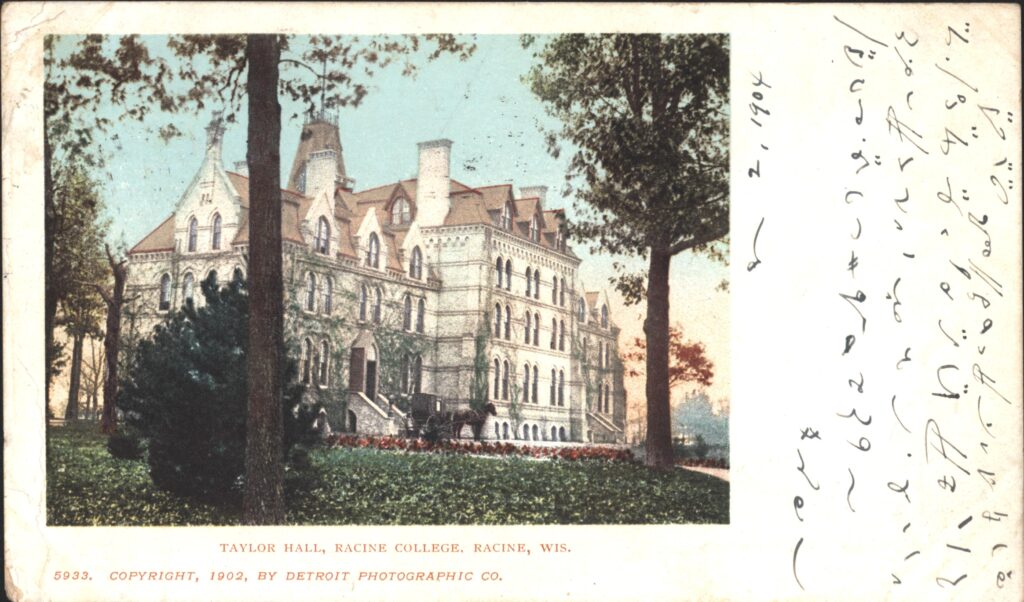
With best regards, sincerely ______
Timeline — work in progress
1851 Idea of Episcopal college first proposed in Milwaukee at convention with Bishop Kemper
March 3, 1852 Charter for college granted
March 10, 1852 First meeting of the board of directors
July 28, 1853 First collegiate year closed with 33 students, first commencement was held
September 14, 1853 Park Hall finished and ready for occupancy.
September 7, 1859, Dr. Park resigns as president of Racine College and Dr. De Koven takes over as rector, joining St. John’s Hall at Nashotah to Racine College.
January 15, 1864, Park Hall except for one wing burns to the ground.
August 18, 1864, corner stone for chapel is laid by Bishop Kemper.
1871-1875, two buildings built between the original two halls, completing the quadrangle.
February 4, 1875, Taylor Hall burns because of a defective flue.
March 19, 1879 Dr. James De Koven dies of apoplexy
1887 Collegiate department closes
August 20, 1919 Racine College Is Not Lost To City. Arthur Ehrlich says that local institution will not abandon its educational efforts.
April 26, 1922 Racine College victor in suit against heirs of Charles Wright, original donor of land to college, who felt the land should revert to them.
January 16, 1923 Racine College may be reopened … details are being worked out.
September 15, 1924 Racine College School for Boys will reopen. John B. Cushman, headmaster. Rev. R. H. M. Baker, Warden.
July 6, 1927 Stephen Cushman marries Miss Wustum
October 12, 1927 Fr. Baker resigns due to bronchitis
January 27, 1928 Gymnasium and natatorium burns.
December 21, 1935 Receiver discharged in college case. Nashotah House against the Racine College board of directors and Anne Cushman
Sources for Racine College page:
Historical Sketch of Racine College by Homer Wheeler, 1876
Notes from the DeKoven Center Archives, Issue 2 — March 2018
Racine College Mercury 1927 yearbook: http://www.vindustries.com/RacineCollegeMercury1927/RacineCollegeMercury1927June.pdf
